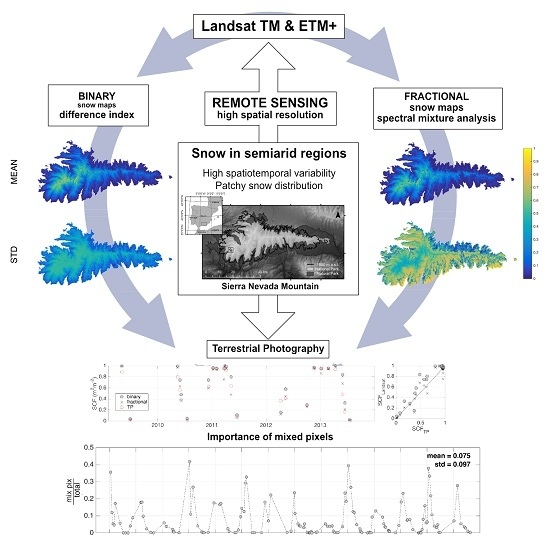Quantifying Snow Cover Distribution in Semiarid Regions Combining Satellite and Terrestrial Imagery
Abstract
1. Introduction
2. Study Site and Available Data
3. Methods
3.1. Landsat Pre-Processing
3.2. Snow Cover Maps
3.2.1. Binary Snow Cover Maps
3.2.2. Fractional Snow Cover Maps from Spectral Mixture Analysis
3.2.3. Snow Cover Maps Validation
High Resolution Snow Cover Maps from Terrestrial Photography
Performance Indicators of the Snow Cover Map Algorithms
4. Results
4.1. Snow Cover Map Series from Landsat Analysis
4.2. Snow Cover Map Validation from Terrestrial Photography
4.3. Snow Cover Evolution from SMA Snow Maps
5. Discussion
6. Conclusions
Acknowledgments
Author Contributions
Conflicts of Interest
References
- Barnett, T.P.; Adam, J.C.; Lettenmaier, D.P. Potential impacts of a warming climate on water availability in snow-dominated regions. Nature 2005, 438, 303–309. [Google Scholar] [CrossRef] [PubMed]
- Giorgi, F. Climate change hot-spots. Geophys. Res. Lett. 2006, 33, L08707. [Google Scholar] [CrossRef]
- Aguilar, C.; Herrero, J.; Polo, M.J. Topographic effects on solar radiation distribution in mountainous watersheds and their influence on reference evapotranspiration estimates at watershed scale. Hydrol. Earth Syst. Sci. 2010, 14, 2479–2494. [Google Scholar] [CrossRef]
- López-Moreno, J.I.; Vicente-Serrano, S.M.; Morán-Tejeda, E.; Lorenzo-Lacruz, J.; Kenawy, A.; Beniston, M. Effects of the North Atlantic Oscillation (NAO) on combined temperature and precipitation winter modes in the Mediterranean mountains: Observed relationships and projections for the 21st century. Glob. Planet. Chang. 2011, 77, 62–76. [Google Scholar] [CrossRef]
- Kuentz, A.; Arheimer, B.; Hundecha, Y.; Wagener, T. Understanding hydrologic variability across Europe through catchment classification. Hydrol. Earth Syst. Sci. 2017, 21, 2863–2879. [Google Scholar] [CrossRef]
- Ionita, M.; Tallaksen, L.M.; Kingston, D.G.; Stagge, J.H.; Laaha, G.; Van Lanen, H.A.J.; Scholz, P.; Chelcea, S.M.; Haslinger, K. The European 2015 drought from a climatological perspective. Hydrol. Earth Syst. Sci. 2017, 21, 1397–1419. [Google Scholar] [CrossRef]
- Garambois, P.A.; Roux, H.; Larnier, K.; Castaings, W.; Dartus, D. Characterization of process-oriented hydrologic model behavior with temporal sensitivity analysis for flash floods in Mediterranean catchments. Hydrol. Earth Syst. Sci. 2013, 17, 2305–2322. [Google Scholar] [CrossRef]
- Pimentel, R.; Herrero, J.; Polo, M.J. Subgrid parameterization of snow distribution at a Mediterranean site using terrestrial photography. Hydrol. Earth Syst. Sci. 2017, 21, 805–820. [Google Scholar] [CrossRef]
- Pimentel, R.; Herrero, J.; Zeng, Y.; Su, Z.; Polo, M.J. Study of Snow Dynamics at Subgrid Scale in Semiarid Environments Combining Terrestrial Photography and Data Assimilation Techniques. J. Hydrometeorol. 2015, 16, 563–578. [Google Scholar] [CrossRef]
- Ménard, C.B.; Essery, R.; Pomeroy, J. Modelled sensitivity of the snow regime to topography, shrub fraction and shrub height. Hydrol. Earth Syst. Sci. 2014, 18, 2375–2392. [Google Scholar] [CrossRef]
- Winstral, A.; Elder, K.; Davis, R.E. Spatial Snow Modeling of Wind-Redistributed Snow Using Terrain-Based Parameters. J. Hydrometeorol. 2002, 3, 524–538. [Google Scholar] [CrossRef]
- Pimentel, R.; Aguilar, C.; Herrero, J.; Pérez-Palazón, M.J.; Polo, M.J. Comparison between Snow Albedo Obtained from Landsat TM, ETM+ Imagery and the SPOT VEGETATION Albedo Product in a Mediterranean Mountainous Site. Hydrology 2016, 3, 10. [Google Scholar] [CrossRef]
- Notarnicola, C.; Duguay, M.; Moelg, N.; Schellenberger, T.; Tetzlaff, A.; Monsorno, R.; Costa, A.; Steurer, C.; Zebisch, M. Snow Cover Maps from MODIS Images at 250 m Resolution, Part 1: Algorithm Description. Remote Sens. 2013, 5, 110–126. [Google Scholar] [CrossRef]
- Notarnicola, C.; Duguay, M.; Moelg, N.; Schellenberger, T.; Tetzlaff, A.; Monsorno, R.; Costa, A.; Steurer, C.; Zebisch, M. Snow Cover Maps from MODIS Images at 250 m Resolution, Part 2: Validation. Remote Sens. 2013, 5, 1568–1587. [Google Scholar] [CrossRef]
- Dozier, J.; Painter, T.H. Multispectral and Hyperspectral Remote Sensing of Alpine Snow Properties. Annu. Rev. Earth Planet. Sci. 2004, 32, 465–494. [Google Scholar] [CrossRef]
- Cui, Y.; Xiong, C.; Lemmetyinen, J.; Shi, J.; Jiang, L.; Peng, B.; Li, H.; Zhao, T.; Ji, D.; Hu, T. Estimating Snow Water Equivalent with Backscattering at X and Ku Band Based on Absorption Loss. Remote Sens. 2016, 8, 505. [Google Scholar] [CrossRef]
- Gao, Y.; Xie, H.; Lu, N.; Yao, T.; Liang, T. Toward advanced daily cloud-free snow cover and snow water equivalent products from Terra–Aqua MODIS and Aqua AMSR-E measurements. J. Hydrol. 2010, 385, 23–35. [Google Scholar] [CrossRef]
- Thirel, G.; Notarnicola, C.; Kalas, M.; Zebisch, M.; Schellenberger, T.; Tetzlaff, A.; Duguay, M.; Mölg, N.; Burek, P.; de Roo, A. Assessing the quality of a real-time Snow Cover Area product for hydrological applications. Remote Sens. Environ. 2012, 127, 271–287. [Google Scholar] [CrossRef]
- Parajka, J.; Blöschl, G. The value of MODIS snow cover data in validating and calibrating conceptual hydrologic models. J. Hydrol. 2008, 358, 240–258. [Google Scholar] [CrossRef]
- Sade, R.; Rimmer, A.; Litaor, M.I.; Shamir, E.; Furman, A. Snow surface energy and mass balance in a warm temperate climate mountain. J. Hydrol. 2014, 519, 848–862. [Google Scholar] [CrossRef]
- Rosenthal, W.; Dozier, J. Automated Mapping of Montane Snow Cover at Subpixel Resolution from the Landsat Thematic Mapper. Water Resour. Res. 1996, 32, 115–130. [Google Scholar] [CrossRef]
- Selkowitz, D.J.; Forster, R.R. Automated mapping of persistent ice and snow cover across the western U.S. with Landsat. ISPRS J. Photogramm. Remote Sens. 2016, 117, 126–140. [Google Scholar] [CrossRef]
- Crawford, C.J.; Manson, S.M.; Bauer, M.E.; Hall, D.K. Multitemporal snow cover mapping in mountainous terrain for Landsat climate data record development. Remote Sens. Environ. 2013, 135, 224–233. [Google Scholar] [CrossRef]
- Pimentel, R.; Herrero, J.; Polo, M.J. Terrestrial photography as an alternative to satellite images to study snow cover evolution at hillslope scale. Proc. SPIE 2012. [Google Scholar] [CrossRef]
- Silasari, R.; Parajka, J.; Ressl, C.; Strauss, P.; Blöschl, G. Potential of time-lapse photography for identifying saturation area dynamics on agricultural hillslopes. Hydrol. Process. 2017, 31, 3610–3627. [Google Scholar] [CrossRef]
- Corripio, J.G. Snow surface albedo estimation using terrestrial photography. Int. J. Remote Sens. 2004, 25, 5705–5729. [Google Scholar] [CrossRef]
- Hall, D.K.; Riggs, G.A.; Salomonson, V.V.; DiGirolamo, N.E.; Bayr, K.J. MODIS snow-cover products. Remote Sens. Environ. 2002, 83, 181–194. [Google Scholar] [CrossRef]
- Painter, T.H.; Rittger, K.; McKenzie, C.; Slaughter, P.; Davis, R.E.; Dozier, J. Retrieval of subpixel snow covered area, grain size, and albedo from MODIS. Remote Sens. Environ. 2009, 113, 868–879. [Google Scholar] [CrossRef]
- Anderson, R.S.; Jiménez-Moreno, G.; Carrión, J.S.; Pérez-Martínez, C. Postglacial history of alpine vegetation, fire, and climate from Laguna de Río Seco, Sierra Nevada, southern Spain. Quat. Sci. Rev. 2011, 30, 1615–1629. [Google Scholar] [CrossRef]
- Heywood, V.H. The Mediterranean flora in the context of world biodiversity. Ecol. Mediterr. 1995, 21, 11–18. [Google Scholar]
- Pérez-Palazón, M.J.; Pimentel, R.; Herrero, J.; Aguilar, C.; Perales, J.M.; Polo, M.J. Extreme values of snow-related variables in Mediterranean regions: Trends and long-term forecasting in Sierra Nevada (Spain). In Proceedings of the International Association of Hydrological Sciences; Copernicus GmbH: Gottingen, Germany, 2015; Volume 369, pp. 157–162. [Google Scholar]
- Dumont, M.; Brissaud, O.; Picard, G.; Schmitt, B.; Gallet, J.-C.; Arnaud, Y. High-accuracy measurements of snow Bidirectional Reflectance Distribution Function at visible and NIR wavelengths—Comparison with modeling results. Atmos. Chem. Phys. 2010, 10, 2507–2520. [Google Scholar] [CrossRef]
- Liang, S.; Fang, H.; Chen, M. Atmospheric correction of Landsat ETM+ land surface imagery. I. Methods. IEEE Trans. Geosci. Remote Sens. 2001, 39, 2490–2498. [Google Scholar] [CrossRef]
- Liang, S.; Stroeve, J.C.; Grant, I.F.; Strahler, A.H.; Duvel, J.P. Angular corrections to satellite data for estimating earth radiation budget. Remote Sens. Rev. 2000, 18, 103–136. [Google Scholar] [CrossRef]
- Chander, G.; Markham, B.L.; Helder, D.L. Summary of current radiometric calibration coefficients for Landsat MSS, TM, ETM+, and EO-1 ALI sensors. Remote Sens. Environ. 2009, 113, 11. [Google Scholar] [CrossRef]
- Moran, M.S.; Jackson, R.D.; Slater, P.N.; Teillet, P.M. Evaluation of simplified procedures for retrieval of land surface reflectance factors from satellite sensor output. Remote Sens. Environ. 1992, 41, 169–184. [Google Scholar] [CrossRef]
- Chavez, P.S., Jr. Image Based Atmospheric Corrections-Revisited and Improved. Photogramm. Eng. Remote Sens. 1996, 62, 1025–1036. [Google Scholar]
- Chavez, P.S. An improved dark-object subtraction technique for atmospheric scattering correction of multispectral data. Remote Sens. Environ. 1988, 24, 459–479. [Google Scholar] [CrossRef]
- Hagolle, O.; Huc, M.; Villa Pascual, D.; Dedieu, G. A Multi-Temporal and Multi-Spectral Method to Estimate Aerosol Optical Thickness over Land, for the Atmospheric Correction of FormoSat-2, LandSat, VENμS and Sentinel-2 Images. Remote Sens. 2015, 7, 2668–2691. [Google Scholar] [CrossRef]
- Gilabert, M.A.; Conese, C.; Maselli, F. An atmospheric correction method for the automatic retrieval of surface reflectances from TM images. Int. J. Remote Sens. 1994, 15, 2065–2086. [Google Scholar] [CrossRef]
- Song, C.; Woodcock, C.E.; Seto, K.C.; Lenney, M.P.; Macomber, S.A. Classification and Change Detection Using Landsat TM Data. Remote Sens. Environ. 2001, 75, 230–244. [Google Scholar] [CrossRef]
- Karnieli, A.; Ben-Dor, E.; Bayarjargal, Y.; Lugasi, R. Radiometric saturation of Landsat-7 ETM+ data over the Negev Desert (Israel): Problems and solutions. Int. J. Appl. Earth Obs. Geoinf. 2004, 5, 219–237. [Google Scholar] [CrossRef]
- Tucker, C.J. Red and photographic infrared linear combinations for monitoring vegetation. Remote Sens. Environ. 1979, 8, 127–150. [Google Scholar] [CrossRef]
- Hantson, S.; Chuvieco, E. Evaluation of different topographic correction methods for Landsat imagery. Int. J. Appl. Earth Obs. Geoinf. 2011, 13, 691–700. [Google Scholar] [CrossRef]
- Dozier, J. Spectral signature of alpine snow cover from the landsat thematic mapper. Remote Sens. Environ. 1989, 28, 9–22. [Google Scholar] [CrossRef]
- Herrero, J.; Polo, M.J.; Losada, M.A. Snow evolution in Sierra Nevada (Spain) from an energy balance model validated with Landsat TM data. Proc. SPIE 2011. [Google Scholar] [CrossRef]
- Roberts, D.A.; Gardner, M.; Church, R.; Ustin, S.; Scheer, G.; Green, R.O. Mapping chaparral in the Santa Monica Mountains using multiple endmember spectral mixture models. Remote Sens. Environ. 1998, 65, 267–276. [Google Scholar] [CrossRef]
- Fiume, E.L. The Mathematical Structure of Raster Graphics; Academic Press: New York, NY, USA, 2014; ISBN 978-1-4832-6082-2. [Google Scholar]
- Foley, J.D. Computer Graphics: Principles and Practice; Addison-Wesley Professional: Reading, MA, USA, 1996; ISBN 978-0-201-84840-3. [Google Scholar]


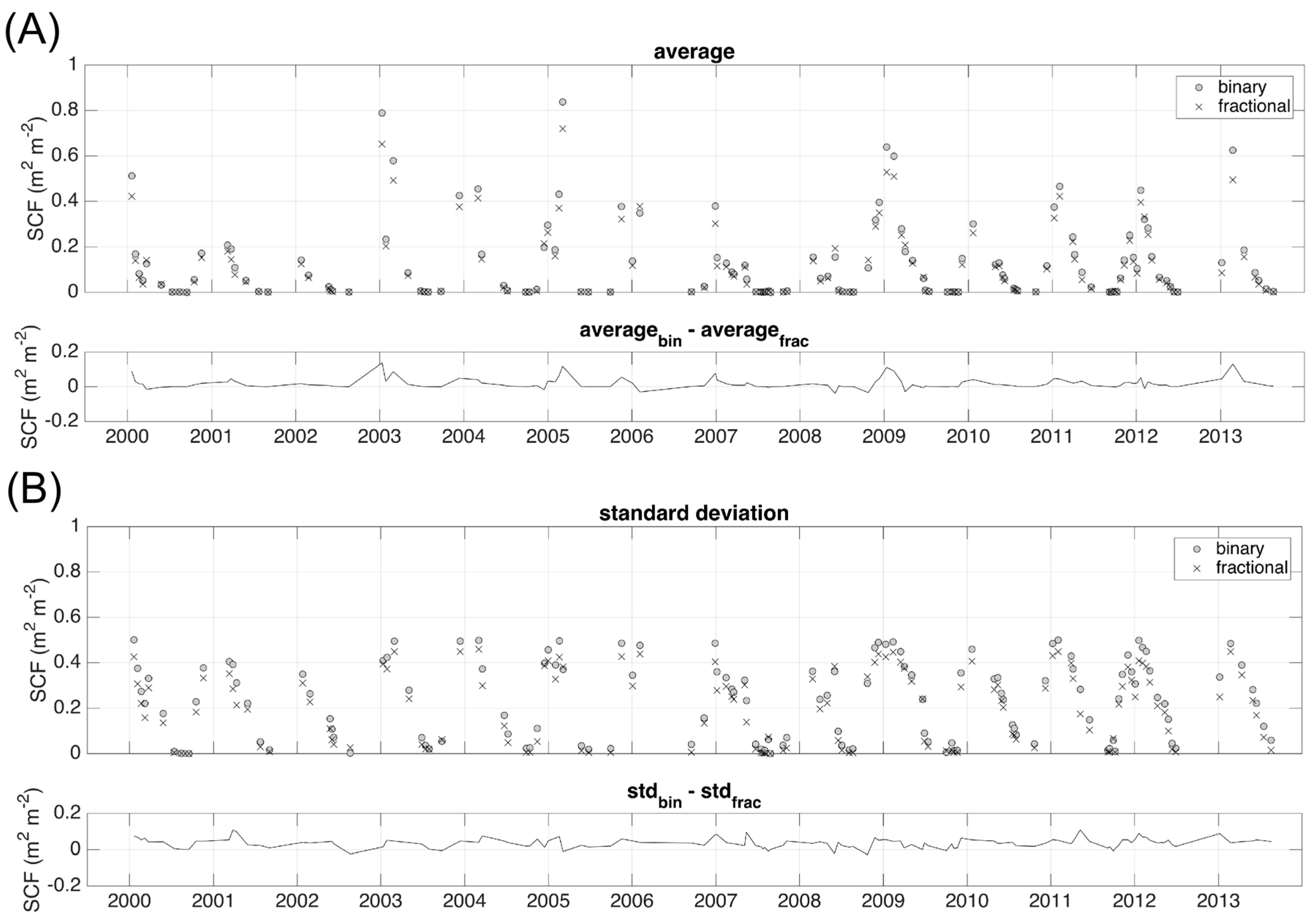
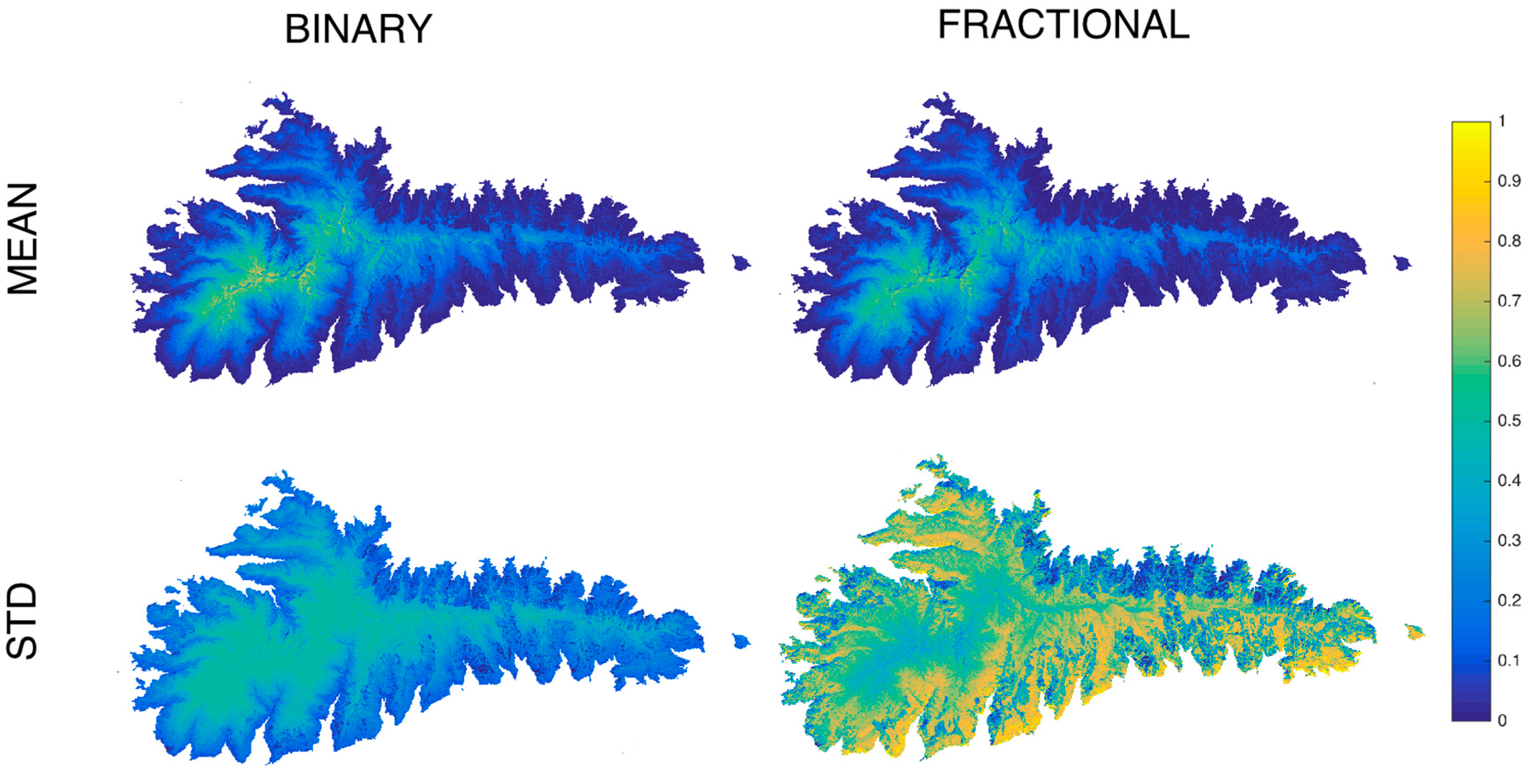
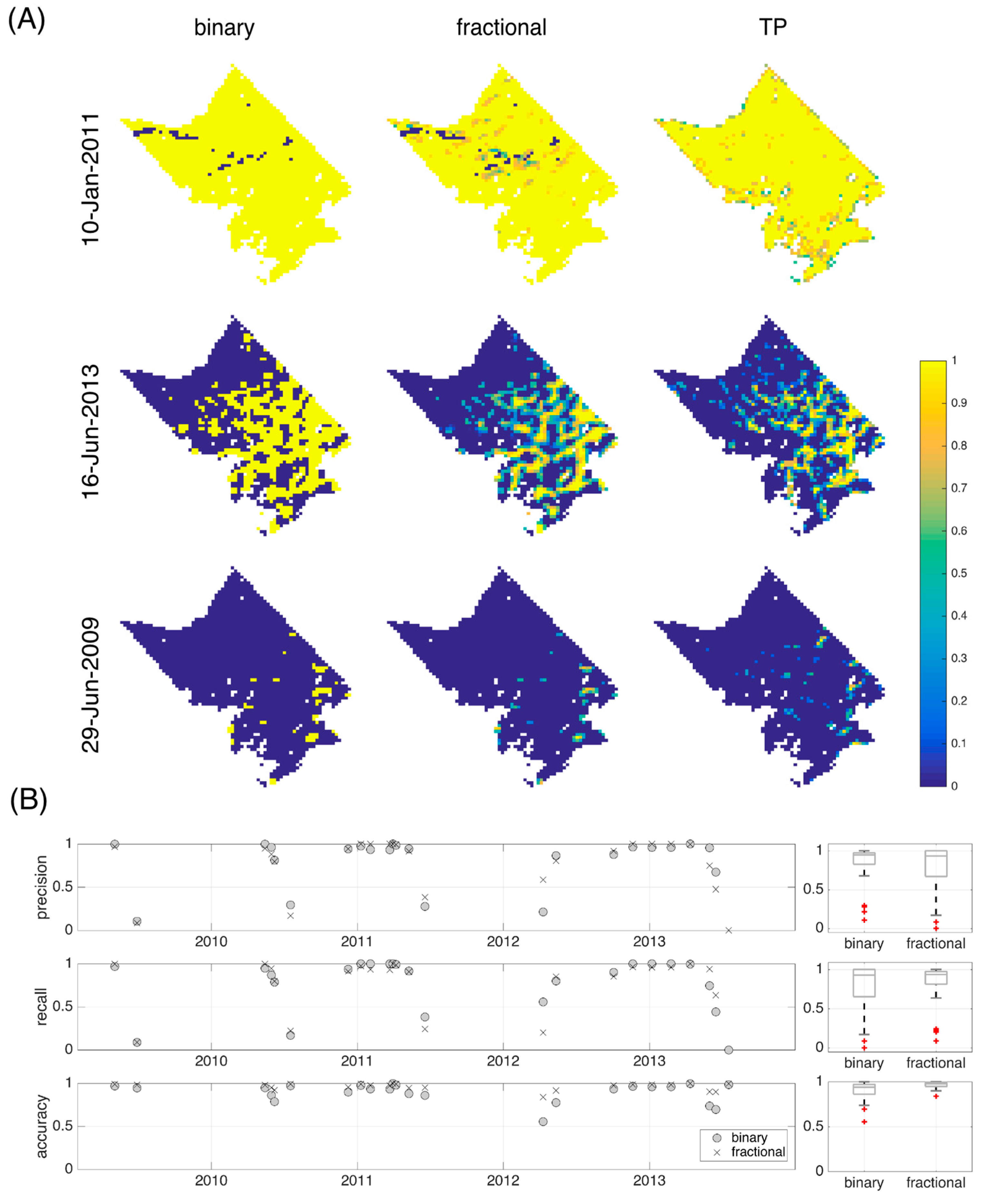

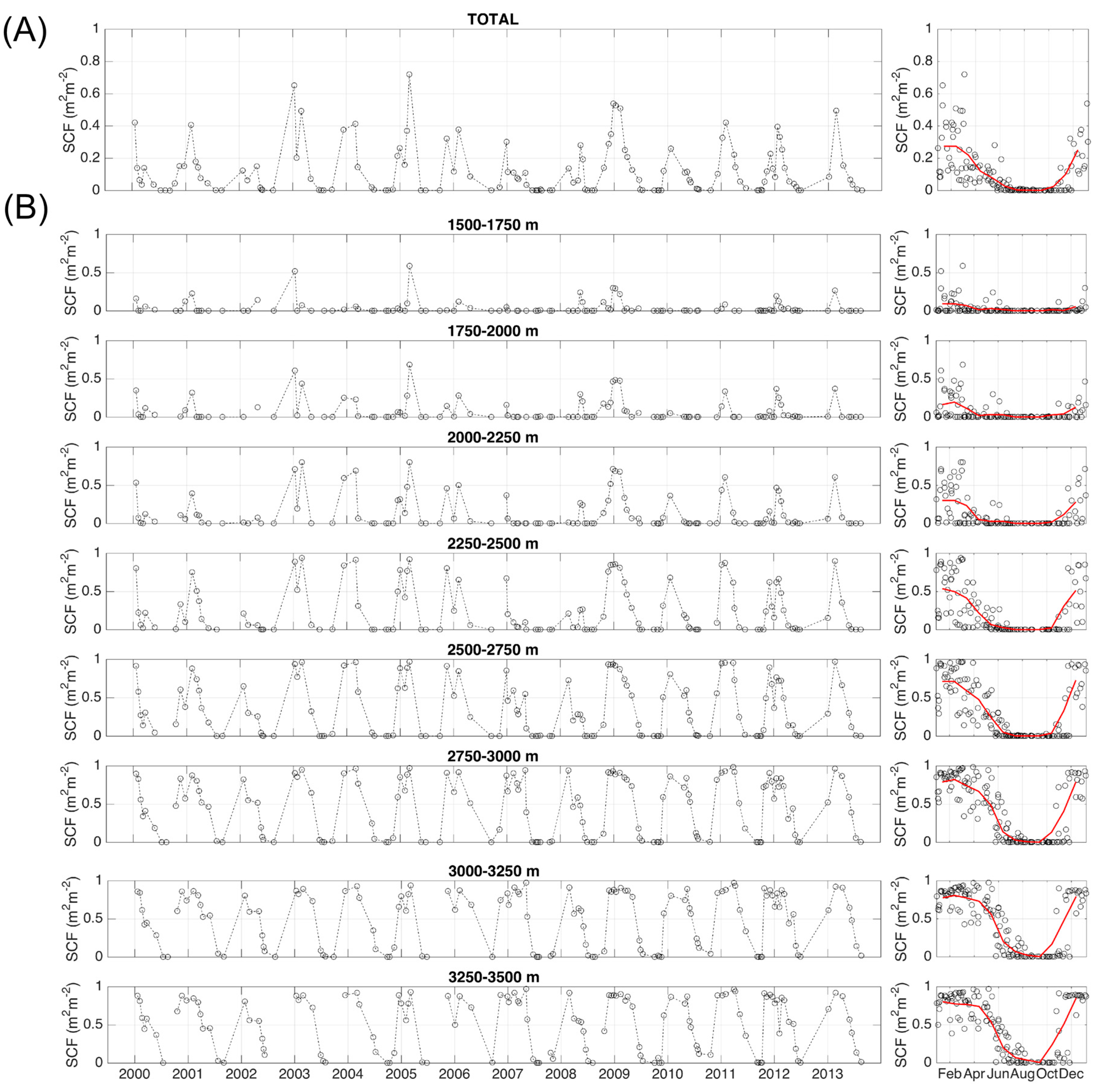

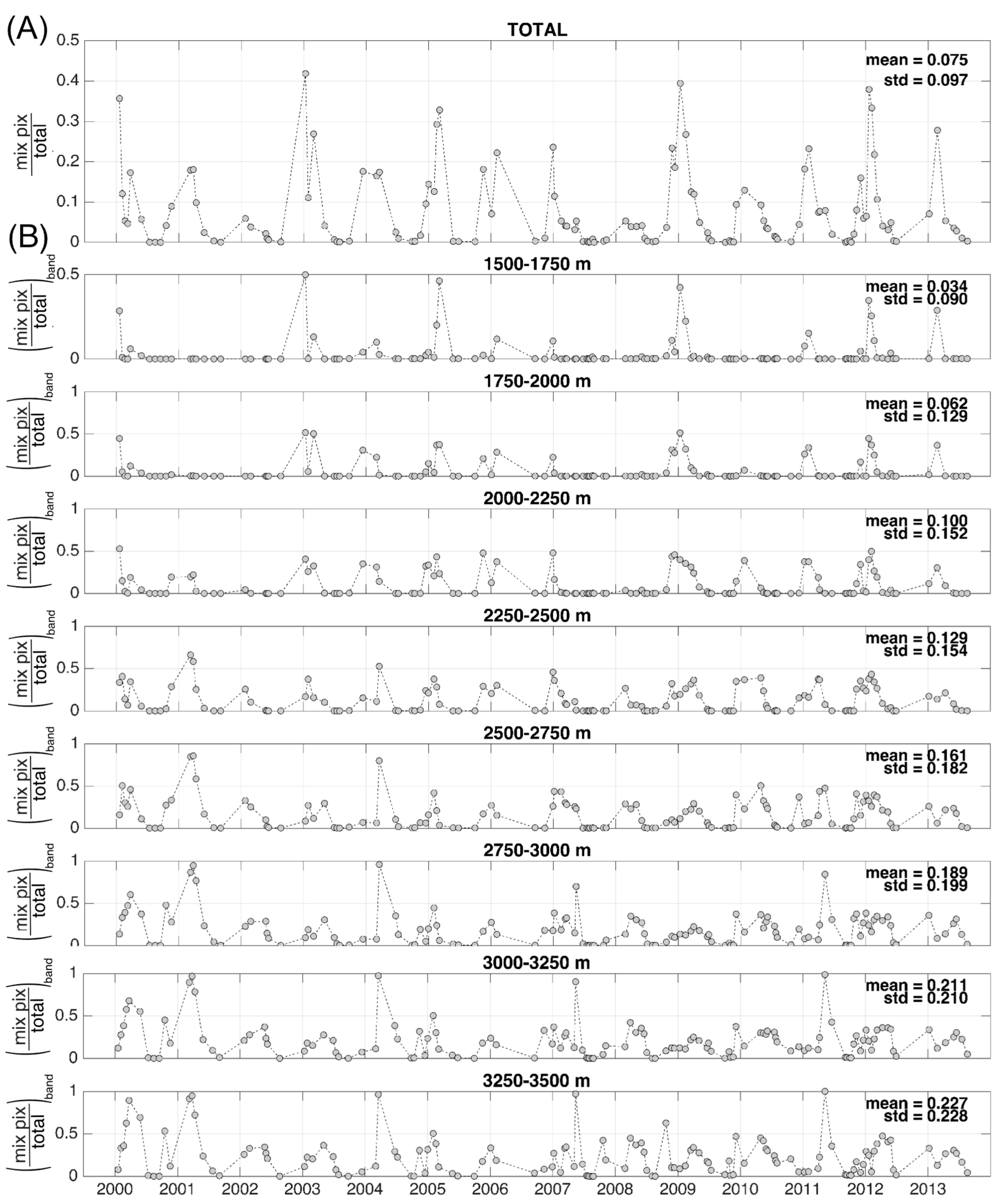
| Facing | Elevation | Precipitation | Temperature | Radiation | Wind Speed |
|---|---|---|---|---|---|
| (mm) | (°C) | (MJ m‒2 day‒1) | (ms‒1) | ||
| South face | High areas | 783.3 (35.8) | 7.8 (6.9) | 11.1 (1.1) | 8.2 (0.5) |
| Low areas | 503.7 (14.8) | 14.8 (7.4) | 9.5 (1.5) | 3.2 (1.4) | |
| North face | High areas | - | 6.8 (5.6) | 10.9 (0.3) | 5.1 (2.2) |
| Low areas | 526.7 (116.3) | 9.7 (4.5) | 9.4 (1.2) | 2.4 (1.3) |
| Date | (km2) | (km2) | (km2) | (km2) | (km2) | ||
|---|---|---|---|---|---|---|---|
| 4 May 2009 | 1.90 | 1.88 | 1.71 | 0.19 | 0.111 | 0.17 | 0.099 |
| 29 June 2009 | 0.06 | 0.04 | 0.04 | 0.02 | 0.500 | 0.00 | 0.000 |
| 15 May 2010 | 1.90 | 1.88 | 1.67 | 0.23 | 0.138 | 0.21 | 0.126 |
| 31 May 2010 | 1.58 | 1.35 | 1.24 | 0.34 | 0.274 | 0.11 | 0.089 |
| 8 June 2010 | 1.03 | 0.80 | 0.82 | 0.21 | 0.256 | −0.02 | −0.024 |
| 18 July 2010 | 0.04 | 0.02 | 0.02 | 0.02 | 1.000 | 0.00 | 0.000 |
| 9 December 2010 | 1.64 | 1.33 | 1.45 | 0.19 | 0.131 | −0.12 | −0.083 |
| 10 January 2011 | 1.86 | 1.83 | 1.83 | 0.03 | 0.016 | 0.00 | 0.000 |
| 3 February 2011 | 1.79 | 1.75 | 1.83 | −0.04 | −0.022 | −0.08 | −0.044 |
| 31 March 2011 | 1.90 | 1.90 | 1.83 | 0.07 | 0.038 | 0.07 | 0.038 |
| 8 April 2011 | 1.88 | 1.81 | 1.81 | 0.07 | 0.039 | 0.00 | 0.000 |
| 10 May 2011 | 1.67 | 1.03 | 1.45 | 0.22 | 0.152 | −0.42 | −0.290 |
| 19 June 2011 | 0.17 | 0.10 | 0.17 | 0.00 | 0.000 | −0.07 | −0.412 |
| 12 May 2012 | 1.31 | 1.01 | 0.91 | 0.40 | 0.440 | 0.10 | 0.110 |
| 7 January 2013 | 1.83 | 1.69 | 1.83 | 0.00 | 0.000 | −0.14 | −0.077 |
| 24 February 2013 | 1.83 | 1.81 | 1.83 | 0.00 | 0.000 | −0.02 | −0.011 |
| 13 April 2013 | 1.90 | 1.88 | 1.83 | 0.07 | 0.038 | 0.05 | 0.027 |
| 31 May 2013 | 1.73 | 1.46 | 1.08 | 0.65 | 0.602 | 0.38 | 0.352 |
| 16 June 2013 | 0.74 | 0.46 | 0.36 | 0.38 | 1.056 | 0.10 | 0.278 |
| 18 July 2013 | 0.02 | 0.02 | 0.00 | 0.02 | 0.02 |
© 2017 by the authors. Licensee MDPI, Basel, Switzerland. This article is an open access article distributed under the terms and conditions of the Creative Commons Attribution (CC BY) license (http://creativecommons.org/licenses/by/4.0/).
Share and Cite
Pimentel, R.; Herrero, J.; Polo, M.J. Quantifying Snow Cover Distribution in Semiarid Regions Combining Satellite and Terrestrial Imagery. Remote Sens. 2017, 9, 995. https://doi.org/10.3390/rs9100995
Pimentel R, Herrero J, Polo MJ. Quantifying Snow Cover Distribution in Semiarid Regions Combining Satellite and Terrestrial Imagery. Remote Sensing. 2017; 9(10):995. https://doi.org/10.3390/rs9100995
Chicago/Turabian StylePimentel, Rafael, Javier Herrero, and María José Polo. 2017. "Quantifying Snow Cover Distribution in Semiarid Regions Combining Satellite and Terrestrial Imagery" Remote Sensing 9, no. 10: 995. https://doi.org/10.3390/rs9100995
APA StylePimentel, R., Herrero, J., & Polo, M. J. (2017). Quantifying Snow Cover Distribution in Semiarid Regions Combining Satellite and Terrestrial Imagery. Remote Sensing, 9(10), 995. https://doi.org/10.3390/rs9100995





